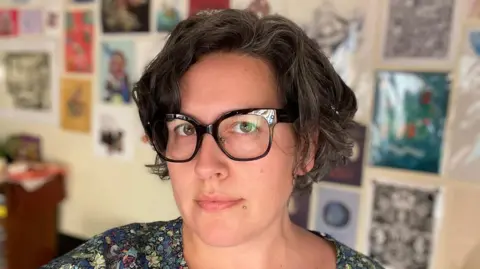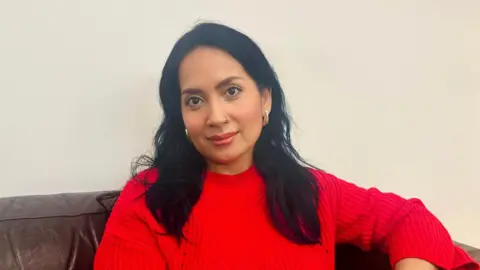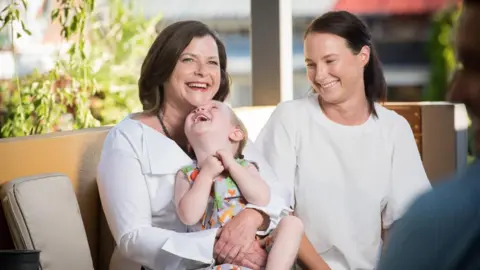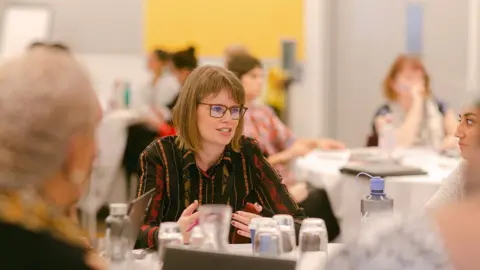By Hannah Ritchie, BBC News, Sydney
 Heidi Metcalf
Heidi MetcalfThere is one memory, or more precisely one moment, that defined Heidi Metcalf’s second birth.
It wasn’t saying goodbye to her husband and newborn before being wheeled into surgery, nor was it the heart attack she thought she was having as she lay on the table.
This is when an obstetrician “ripped the placenta” from her body, without a word or warning.
As a nurse, Ms. Metcalf knew that the procedure, although extremely painful, was necessary. She could not expel it naturally, causing potentially fatal bleeding.
But she had “never seen or met this man before,” and she cannot forget that his consent, during one of the most traumatic experiences of her life, “meant so little.”
“I felt like there was a violation. I needed to feel involved in what was happening to my body, not just a spectator.”
Ms Metcalf is one of thousands of Australian women who have come forward to tell their stories after the federal government convened a team of experts to tackle what it calls “medical misogyny”.
So far, they’ve found that two-thirds of women nationally have faced gender bias or discrimination in health care.
Many women say the pain occurs when they are most vulnerable, such as during intimate examinations or, like Ms Metcalf, during childbirth. Others say their pain is ignored or misdiagnosed.
For this article, the BBC interviewed six women. They spoke about their experiences of being called “anxious”, “insistent” or even “hysterical” when seeking treatment for a range of debilitating symptoms.
They also said they felt that the pain of the men around them seemed to be systematically taken more seriously.
“I just don’t feel safe”
A Singapore doctor once told Nadiah Akbar that the extreme fatigue she was feeling was due to the “stress” of being a busy mother. Tests later revealed that it was thyroid cancer.
 Nadia Akbar
Nadia AkbarYears later, when she was in remission and had emigrated to Australia, staff at a Melbourne hospital failed to diagnose a torn cartilage in her hip or a herniated disc in her back.
Instead, they suggested the crippling pain could be linked to “depression” or “excessive fatigue.” That led Ms Akbar to pay out of pocket for two expensive MRI scans to have her case taken seriously.
“Oh, it’s nothing. I’ve heard that statement so many times… It’s really discouraging for a human being to hear that over and over again,” she said.
“It takes a lot of energy to keep advocating, and that’s what’s worrying: a lot of people just stop.”
Laura – who asked that her name be changed – is close to that point, after years of seeing symptoms of what would ultimately be confirmed as a head injury ruled out.
“I don’t get health care without my partner by my side, that’s a general rule,” she says, explaining that she feels her concerns are taken “more seriously” when expressed by a man.
“I don’t feel safe in the system because when you’re young and you’re constantly told that it’s all in your head, it’s easy to believe it.”
Like so many others across the country, both women say they are coming forward to share their experiences in order to seize this promised moment of change.
Assistant Health Minister Ged Kearney, who chairs the national council examining these issues, says their stories, along with those of countless others facing additional disadvantage in First Nations, LGBTQ+ and migrant communities, will guide his work.
His team’s mandate is broad and vast areas of interest have already emerged.
But solving gender inequality in medicine is no small feat, and Australia’s attempts could have far-reaching consequences as other nations consider reforms.
 Ged Kearney
Ged Kearney“A unique approach for all”
The problem is not that “all health professionals have a definite agenda against women,” Kearny says.
Rather, it is that prejudices are embedded in the structure of modern medicine because, for centuries, it has been “delivered by and designed for” men.
Women’s health – on the other hand – was often rooted in pernicious gender myths and stereotypes.
“Hysteria,” a now-defunct medical term, was a catch-all diagnosis for women with a range of symptoms, meaning their pain was attributed to emotional rather than biological causes.
But today, some women say they continue to feel trapped, disbelieved and patronized in medical settings.
The lack of diversity in medical research further compounds the problem.
According to public health expert Professor Robyn Norton, more than 70% of participants in early-stage clinical trials worldwide are still white men, while male cells and animals are used as the standard in the laboratory.
The findings are then applied to women, intersex, trans and gender diverse people, posing challenges for their treatment, diagnosis and how their symptoms are understood, Professor Norton says.
She describes it as a “one-size-fits-all, male-centred” approach to health care that has created huge gaps in knowledge.
A 2019 analysis by the Novo Nordisk Foundation’s Center for Protein Research – which used data from the entire Danish population – found that of 770 diseases studied, women were diagnosed later than men, with an average lag of four years.
In Australia, a 2018 study by the University of Sydney found that women admitted to hospital with a serious heart attack were half as likely as men to receive appropriate treatment and were twice as likely to die six months after discharge.
Scientists have warned that another obstacle is chronic underinvestment in women’s health issues.
Endometriosis is cited as a key example. Although it affects around 10% of women and girls of reproductive age worldwide, there is no cure and it takes an average of seven years for patients to be diagnosed.
A recent study found that 89% of Australian women were still being advised by health professionals that pregnancy would resolve their symptoms – despite growing evidence that this is medical misconception.
Experts say these disparities are being recognized and studied globally, with countries comparing notes on what might be the best approach.
The United Kingdom recently announced measures to close the “gender health gap” in its health system. In the United States, the federal government has launched an initiative to improve funding and research into women’s health, led by First Lady Jill Biden.
 Bonney Corbin/Australian Women’s Health Alliance
Bonney Corbin/Australian Women’s Health AllianceAustralia is already making progress, Kearny said.
In the past 12 months, his government has opened 22 clinics specializing in endometriosis and pelvic pain, in a bid to improve care and diagnosis.
The country’s medicines regulator has removed restrictions on the prescription and distribution of medical abortion pills in a bid to increase universal access to reproductive health care.
Researchers will soon be able to study how major diseases are experienced by female, intersex and gender-diverse populations at a new centre led by Professor Norton.
She is optimistic that her team’s work could “catalyse the kind of change in Australia that could make the country a leader in this area”.
The latest national budget also includes investments in women’s health. Nearly A$100 million ($66 million; £52 million) has been earmarked for projects such as reducing medical costs for gynaecological conditions, as well as studies into menopause, miscarriage and fertility. These are areas that have historically been underfunded.
But while advocates like Bonney Corbin – the chair of the Australian Women’s Health Alliance who also sits on the council – have welcomed the cash injection, they say it doesn’t go far enough and state governments should also take responsibility.
“A gender-responsive approach to health care is not limited to funding projects related to breasts and uteruses. We need to consider women’s bodies as a whole,” she explains.
In the coming months, Ms. Kearney’s advisory committee will release its first set of major reform recommendations.
She says she has no intention of proposing “tick-the-box” measures that merely patch things up.
Instead, she said, the long-term goal is to create a model to “build a health care system that actually works for everyone.”
Whether this advice will lead to lasting change remains an open question despite the involvement of the deputy health minister at this stage, Corbin says.
If not, she suggests there could be a negative public reaction.
“We have mobilized a large number of women in this process. Now we need to take action.”
